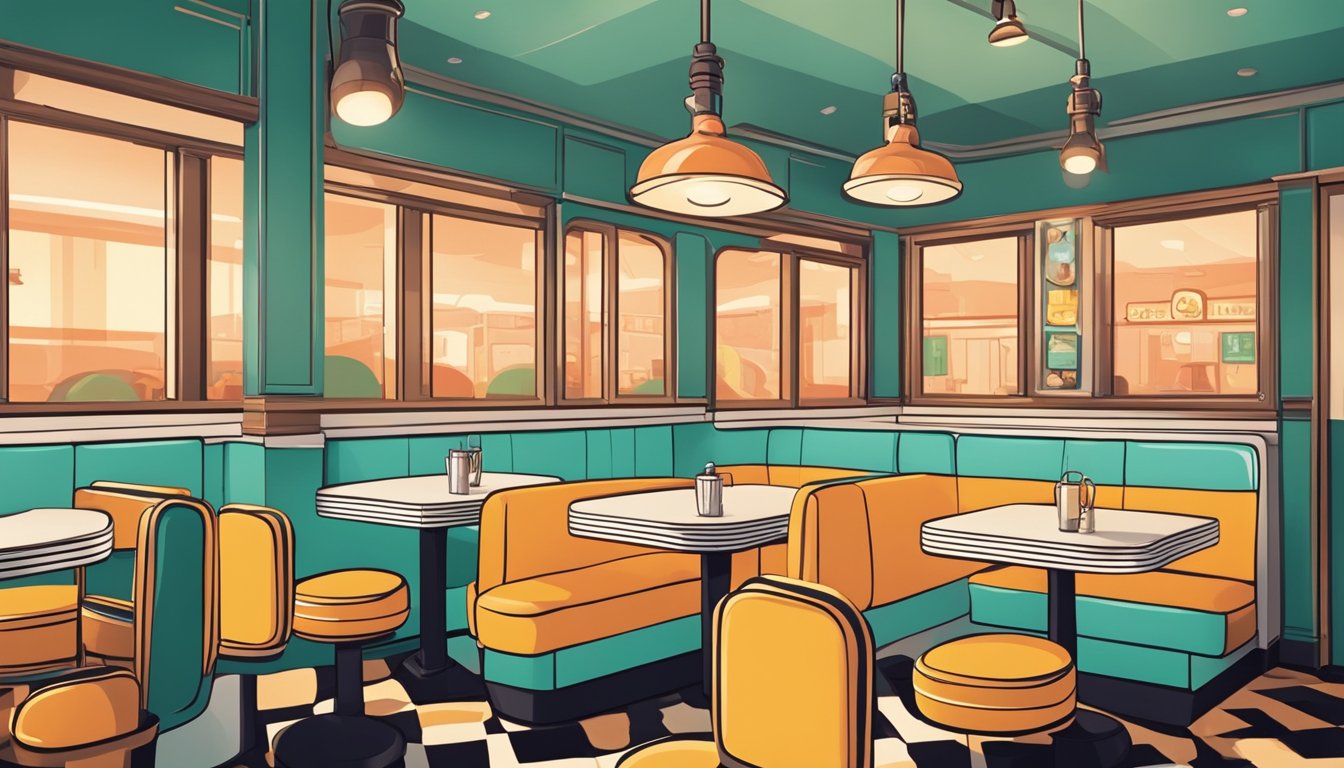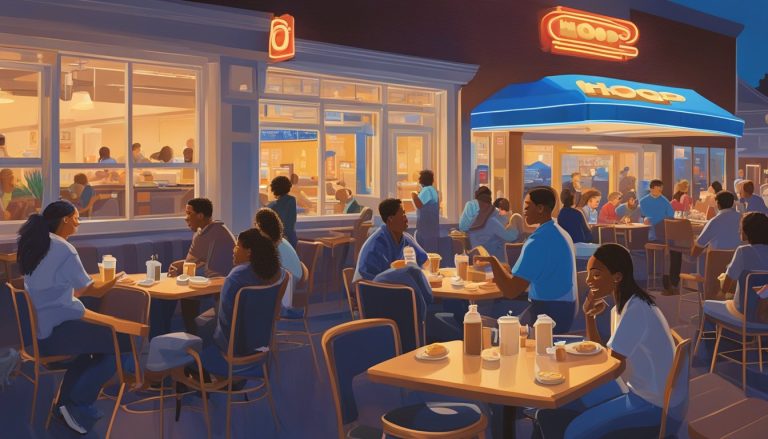IHOP’s iconic blue roof and homey atmosphere have become familiar sights across America. The interior design of these popular pancake houses plays a crucial role in shaping customer experiences and perceptions. IHOP’s thoughtful use of color, lighting, and layout aims to create a welcoming environment that encourages relaxation and social connection.
The International House of Pancakes, better known as IHOP, has carefully crafted its restaurant interiors to align with its brand identity as a casual dining establishment. Warm earth tones, comfortable booth seating, and soft lighting work together to evoke feelings of comfort and nostalgia. These design choices reflect an understanding of how physical spaces can influence mood and behavior.
IHOP’s design strategy extends beyond aesthetics to address practical concerns in the restaurant industry. The layout optimizes traffic flow for servers and patrons, while the color palette stimulates appetite. By applying principles of environmental psychology, IHOP has created spaces that support its business goals while providing a pleasant dining experience for customers.
The Role of Ambiance in IHOP’s Business Model

IHOP’s interior design plays a crucial part in attracting customers and driving sales growth. The restaurant chain carefully crafts its ambiance to create a comfortable dining experience that appeals to a wide range of patrons.
Creating a Welcoming Atmosphere
IHOP focuses on creating a warm and inviting environment for its customers. The use of soft lighting and warm color schemes helps to establish a cozy atmosphere. Comfortable seating arrangements, including booths and tables, cater to different group sizes and preferences.
The restaurant’s layout is designed to maximize space efficiency while ensuring customer comfort. Open floor plans allow for easy movement and create a sense of spaciousness. IHOP also incorporates elements like family-friendly decor and nostalgic touches to evoke positive emotions and memories.
Balancing Traditional and Modern Designs
IHOP’s interior design strikes a balance between traditional diner aesthetics and modern elements. This approach helps the brand maintain its identity while appealing to changing consumer preferences. Classic features like counter seating and retro-inspired signage are combined with contemporary lighting fixtures and updated color palettes.
The chain regularly updates its interiors to stay relevant and attract new customers. These redesigns often incorporate feedback from franchisees and customer surveys. By refreshing its look periodically, IHOP aims to keep its existing customer base engaged while also attracting younger demographics.
Analyzing IHOP’s Color Choices and Layout

IHOP’s interior design strategically employs color psychology and spatial arrangement to create a welcoming atmosphere for diners. The careful selection of hues and thoughtful layout aim to enhance the casual dining experience while reflecting recent updates to the brand’s visual identity.
Psychological Impact of Color
IHOP’s color palette has evolved from its iconic red, white, and blue to incorporate warmer tones. The interior now features softer shades that promote comfort and appetite stimulation. Warm amber accents in ceiling beams create a cozy ambiance. Yellow elements add touches of cheerfulness and energy to the space.
The shift to warmer colors helps IHOP move away from a fast-food feel towards a more inviting casual dining atmosphere. Blue, still present in the design, evokes trust and stability – qualities IHOP aims to maintain in its brand image.
Arrangement: Maximizing Space and Comfort
IHOP’s layout prioritizes efficient use of space while ensuring customer comfort. Booths line the perimeter, offering privacy and a sense of coziness. Central areas often feature a mix of tables and chairs that can be easily reconfigured for different group sizes.
The open floor plan allows staff to move freely and attend to customers quickly. Lighting fixtures are strategically placed to create well-lit dining areas without harsh glare. This arrangement supports IHOP’s goal of providing a comfortable, casual dining experience for families and groups.
Recent updates have focused on creating a more modern feel while maintaining the restaurant’s welcoming atmosphere. These changes aim to appeal to a broader customer base while retaining IHOP’s core identity as a friendly, accessible dining option.
Lighting and Sensory Experience
IHOP’s interior design carefully considers lighting and sensory elements to create a welcoming atmosphere for diners. The lighting choices and acoustic design work together to enhance the overall dining experience.
Visual Comfort and Menu Legibility
IHOP utilizes a combination of ambient and task lighting to create a comfortable visual environment. Soft, warm overhead lights provide general illumination throughout the restaurant. This creates a cozy atmosphere while ensuring sufficient brightness for navigating the space.
Targeted pendant lights hang over tables, focusing light downward. This design choice enhances menu readability and allows customers to clearly see their food. The focused lighting also creates intimate dining zones, separating individual tables visually.
During daytime hours, many IHOP locations incorporate natural light through large windows. This helps maintain a connection to the outside world and can positively impact customers’ moods.
Auditory Considerations in Design
IHOP’s interior design incorporates elements to manage sound levels and create a pleasant acoustic environment. Textured wall coverings and ceiling treatments help absorb excess noise, reducing echoes and reverberation.
The layout of seating areas is carefully planned to minimize sound travel between tables. This allows for comfortable conversation without excessive noise from neighboring diners. Booth seating, common in many IHOP locations, provides additional sound barriers.
Background music is typically kept at a low volume, providing ambiance without interfering with conversation. The music selection often includes familiar, upbeat tunes that contribute to a positive dining atmosphere.
Brand Identity and Interior Design

IHOP’s interior design plays a crucial role in expressing its brand identity and creating a welcoming atmosphere for customers. The restaurant chain carefully incorporates brand elements and iconic imagery throughout its spaces to reinforce its image.
Incorporating Brand Elements
IHOP integrates its brand colors of blue and white prominently in its interior design. Booths and chairs often feature blue upholstery, while white walls and tabletops create a clean, bright ambiance. The company’s logo appears strategically on walls, menus, and signage.
Lighting fixtures sometimes mimic the shape of pancakes or syrup droplets, subtly reinforcing IHOP’s signature offerings. Wood accents and warm lighting create a cozy, homey feel that aligns with IHOP’s family-friendly brand positioning.
IHOP’s Iconography and Decor
Iconic breakfast imagery adorns IHOP restaurant walls, including photographs or illustrations of pancakes, waffles, and other menu items. These visual cues remind customers of IHOP’s specialty and heritage as a breakfast destination.
Some locations feature nostalgic elements like vintage-style clocks or retro diner accessories, nodding to IHOP’s long history. The new Flip’d by IHOP concept incorporates more modern design elements while maintaining brand recognition through familiar colors and logos.
Menus displayed on walls often highlight signature dishes, reinforcing IHOP’s identity as a go-to spot for breakfast classics and comfort food. This cohesive approach to decor helps create a consistent brand experience across different IHOP locations.
Enhancing Customer Experience

IHOP’s interior design focuses on creating a welcoming atmosphere that appeals to families and encourages repeat visits. The layout and decor choices aim to make dining comfortable and enjoyable for all customers.
Comfortable Seating and Family Focus
IHOP prioritizes spacious booths and tables to accommodate families and groups of various sizes. The seating arrangements allow for easy conversation and shared meals. Highchairs and booster seats are readily available, catering to young children.
The restaurant’s color scheme often features warm tones, creating a cozy ambiance. Soft lighting complements the overall design, making the space inviting for early morning breakfasts or late-night pancake cravings.
Walls may display artwork or photographs related to IHOP’s signature pancakes, reinforcing the brand’s identity and adding visual interest to the dining area.
Interior’s Role in Repeat Business
IHOP’s interior design plays a crucial role in encouraging customers to return. The familiar blue and white color scheme creates a sense of brand consistency across locations. This visual familiarity helps customers feel at ease, even when visiting a new IHOP restaurant.
The open kitchen concept, where visible in some locations, adds to the casual dining experience. It allows customers to see their pancakes being prepared, enhancing transparency and trust.
Comfortable seating and ample table space make it easy for customers to linger, potentially increasing food and beverage sales. The overall design aims to create positive memories associated with family meals and comfort food, prompting customers to choose IHOP for future dining occasions.
Multifunctional Spaces

IHOP’s interior design incorporates versatile areas that serve multiple purposes. These spaces adapt to changing customer needs and operational requirements throughout the day.
Accommodating Dine-in and Takeout Services
IHOP’s layout seamlessly integrates dine-in and takeout services. Dedicated pickup counters near the entrance allow for efficient carryout order retrieval without disrupting seated diners. These areas often feature digital displays showing order status and estimated wait times.
Strategically placed shelving units and warming stations keep takeout and delivery orders organized. This setup enables staff to quickly locate and distribute orders to drivers or customers.
Some locations have implemented separate entrances for dine-in and takeout customers. This design choice reduces congestion and improves traffic flow during peak hours.
Design Flexibility for Events and Peak Hours
IHOP’s multifunctional spaces can be reconfigured to accommodate various events and fluctuating customer volumes. Movable partitions allow staff to create semi-private dining areas for large groups or special occasions.
Modular seating arrangements provide flexibility to adjust table configurations. This adaptability helps maximize seating capacity during busy periods and create a more intimate atmosphere during slower times.
Some IHOP locations feature convertible spaces that transform from dining areas to meeting rooms. These versatile zones can host community events, business gatherings, or birthday parties, expanding the restaurant’s functionality beyond meal service.
Integrating Technology with Design

IHOP has embraced technological advancements to enhance customer experience and operational efficiency. Digital innovations are seamlessly incorporated into the restaurant’s interior design, balancing modern functionality with IHOP’s classic aesthetic.
Online Ordering Efficiency
IHOP’s online ordering system streamlines the dining process for customers and staff alike. The restaurant’s website and mobile app allow patrons to browse menus, customize orders, and pay in advance. This technology integrates with the physical space through dedicated pickup areas, reducing congestion in the dining room.
Digital kiosks are strategically placed near entrances, providing an alternative ordering method for tech-savvy guests. These sleek terminals blend with IHOP’s decor while offering a user-friendly interface.
To accommodate the rise in takeout orders, IHOP has redesigned portions of its interior. Clearly marked pickup shelves and waiting areas ensure smooth traffic flow for both dine-in and takeout customers.
Digital Menu Displays and Mobile App Integration
IHOP incorporates digital menu displays throughout the restaurant, showcasing vibrant images of menu items and promotional offers. These screens seamlessly fit into the overall design scheme, adding a modern touch without disrupting the familiar IHOP atmosphere.
The IHOP mobile app enhances the in-restaurant experience by allowing customers to join virtual waitlists and track their place in line. This feature reduces perceived wait times and allows guests to explore nearby attractions until their table is ready.
At the table, QR codes enable diners to access digital menus on their smartphones, reducing the need for physical menus. This technology not only promotes hygiene but also allows for real-time menu updates and personalized recommendations based on customer preferences.
Adaptations for New Market Trends

IHOP has made strategic changes to its interior design and menu offerings to align with evolving consumer preferences and dining trends. These adaptations aim to attract new customers while retaining loyal patrons.
Responding to Consumer Health Consciousness
IHOP has revamped its menu to include more health-conscious options. The restaurant now offers low-calorie alternatives, gluten-free pancakes, and plant-based protein choices. These additions cater to health-aware diners without compromising on taste.
The interior design reflects this shift towards wellness. Natural materials like wood and stone create a fresh, organic ambiance. Lighting fixtures use warm LEDs to enhance the perception of food quality and freshness.
IHOP has also introduced open-concept kitchens in some locations. This design choice allows customers to see their meals being prepared, reinforcing the idea of fresh, wholesome ingredients.
Innovations in Casual Dining
IHOP’s new design prototype, tested in select locations, aims to modernize the brand’s image. The updated interiors feature a more contemporary color palette, sleek furniture, and stylish artwork that appeals to younger demographics.
The chain has introduced communal seating areas and flexible spaces to accommodate various group sizes. This design change caters to the growing trend of social dining experiences.
IHOP’s Flip’d concept represents a significant innovation in casual dining. These smaller-format restaurants offer quick-service options for busy urban customers. The interior design of Flip’d locations emphasizes efficiency and speed, with streamlined ordering systems and grab-and-go stations.
Digital integration is another key feature of IHOP’s design updates. Self-service kiosks and mobile ordering capabilities have been incorporated to enhance convenience and reduce wait times.
Summary and Future Outlook

IHOP’s interior design strategy aims to create a welcoming atmosphere that encourages customers to linger and return. The company utilizes warm colors, comfortable seating, and strategic lighting to evoke positive emotions.
IHOP’s new prototype design focuses on enhancing the dining experience through modern aesthetics and improved functionality. This redesign aligns with current trends in environmental psychology and biophilic design.
The chain’s efforts to integrate nature-inspired elements and optimize layouts may contribute to increased customer satisfaction and potentially boost sales growth. By creating spaces that reduce stress and improve well-being, IHOP positions itself to attract a wider customer base.
Marketing efforts highlighting the updated interiors could draw attention to IHOP’s commitment to customer comfort. As the company continues to refine its approach, it may further leverage interior design psychology to strengthen brand loyalty and differentiate itself in the competitive restaurant market.
Future developments in IHOP’s interior design strategy may incorporate more personalized experiences and technology integration, adapting to evolving consumer preferences and dining habits. This ongoing evolution of IHOP’s spaces will likely play a crucial role in shaping the brand’s identity and success in the coming years.




